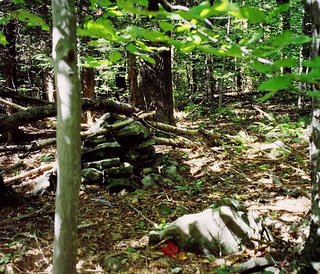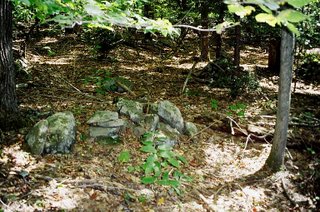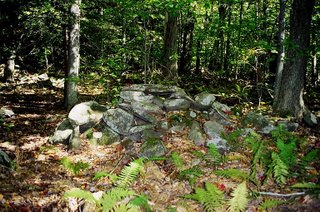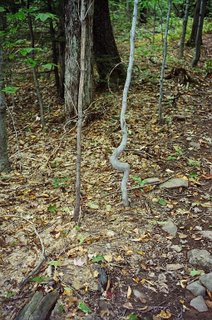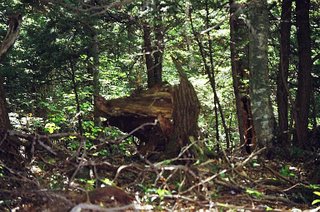Vacation Stones, Part 4: Modern Rocks and Rockpiles
On the same mountain, not far away, but in a very different-looking section, we found some modern stone construction. This was some way off the trail, where I was lured (as the builders probably were) by the odd trees and interestingly-shaped boulders. I know nothing about who did these things. There was a circle of small stones set into the ground, and some rocks not far away placed for a campfire. The nicest thing was this obviously recent pile on a boulder:

These stones were part of the same complex. Someone was having a good time. But what leads people to build with stones in these places? I wonder sometimes whether the impulse arises in ways not yet fully understood, a subconscious impulse, you might say, triggered by something we're barely aware of.

Elsewhere in Ulster County is a different scale of drystone construction. The builder in this case is known--artist and professor Harvey Fite. He worked alone for 37 years, using only his hands and traditional quarrymen's tools to create this extraordinary work of art and landscape called Opus 40.
 Rising out of the bedrock, it covers more than six acres. He created statuary for it, too, and topped it off with a standing megalith such as you might see in Europe. At the site, they explain how he stood the thing up and set it in there.
Rising out of the bedrock, it covers more than six acres. He created statuary for it, too, and topped it off with a standing megalith such as you might see in Europe. At the site, they explain how he stood the thing up and set it in there.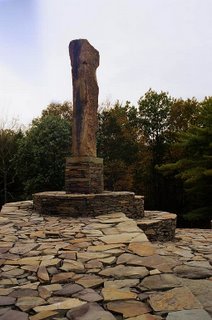 The only unfortunate aspect is the great numbers of mosquitoes that breed in the ponds created by the sculpture, but the place is beautiful, the product of one of those eccentric and driven artists who add so much interest to the world.
The only unfortunate aspect is the great numbers of mosquitoes that breed in the ponds created by the sculpture, but the place is beautiful, the product of one of those eccentric and driven artists who add so much interest to the world. It's all set, as is just about everything in Ulster County, against the backdrop of the Catskill Mountains. [The white spot in the picture, by the way, is not a 'plasma ball' or mystic entity, but a mosquito caught in the flash--I saw it through the lens when I took it.]
It's all set, as is just about everything in Ulster County, against the backdrop of the Catskill Mountains. [The white spot in the picture, by the way, is not a 'plasma ball' or mystic entity, but a mosquito caught in the flash--I saw it through the lens when I took it.] The place is worth a visit. There's a Quarrymen's Museum containing many quarrymen's tools such as Flite used. It's another facet of mankind's impulse to build in stone.
The place is worth a visit. There's a Quarrymen's Museum containing many quarrymen's tools such as Flite used. It's another facet of mankind's impulse to build in stone.What's that about?




